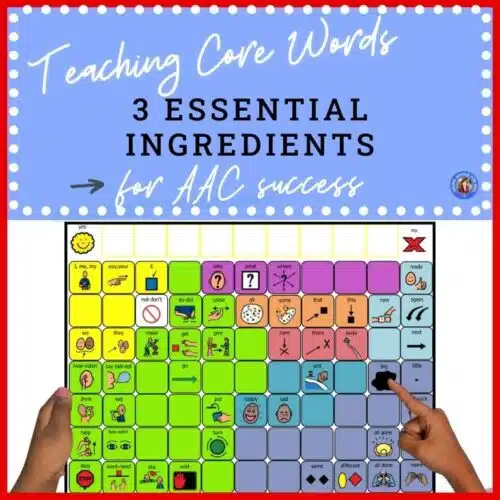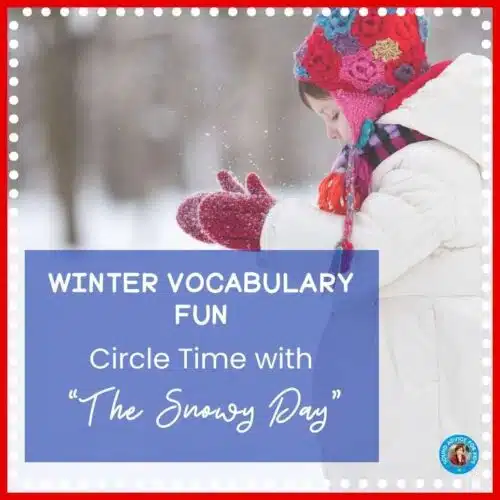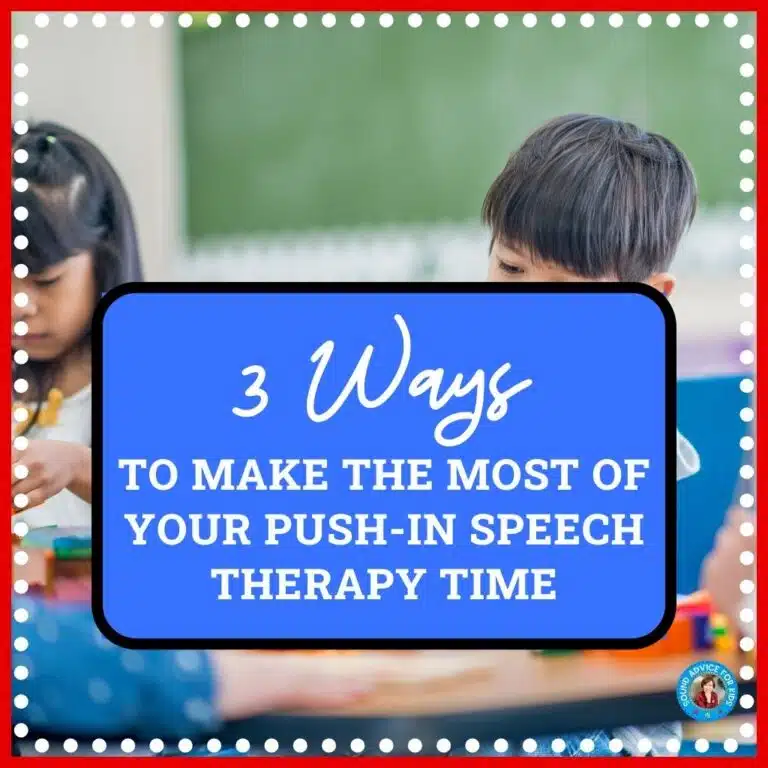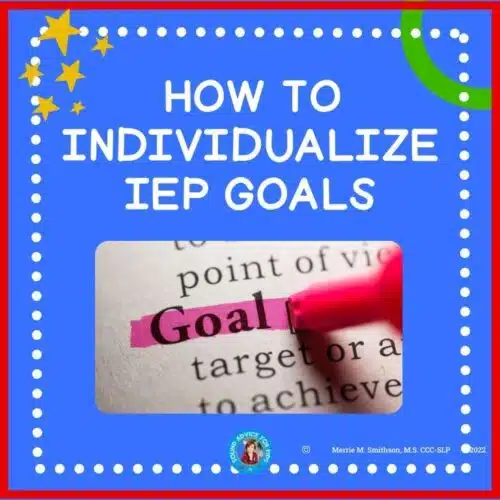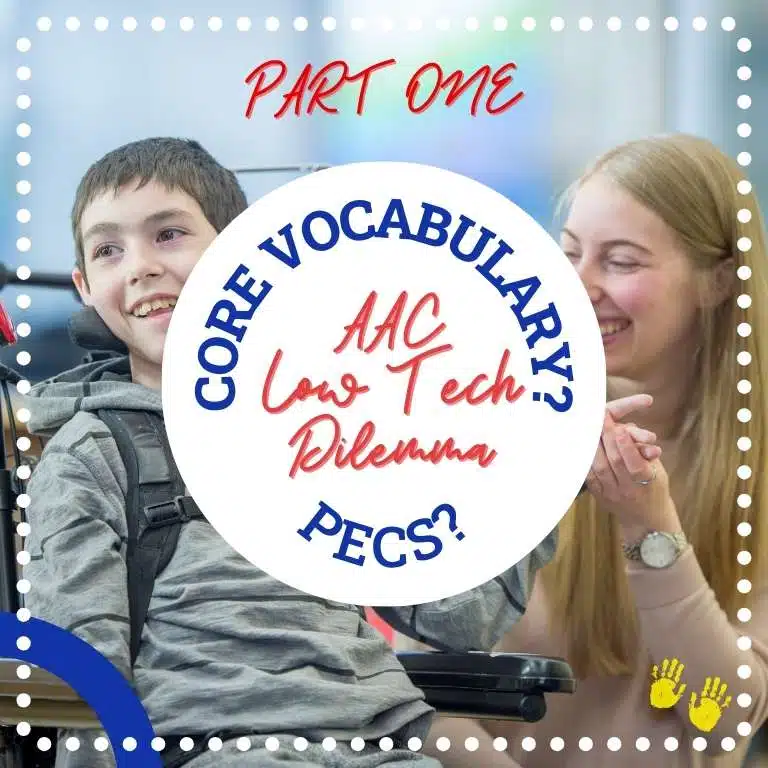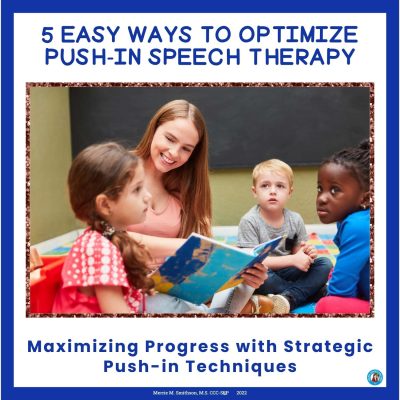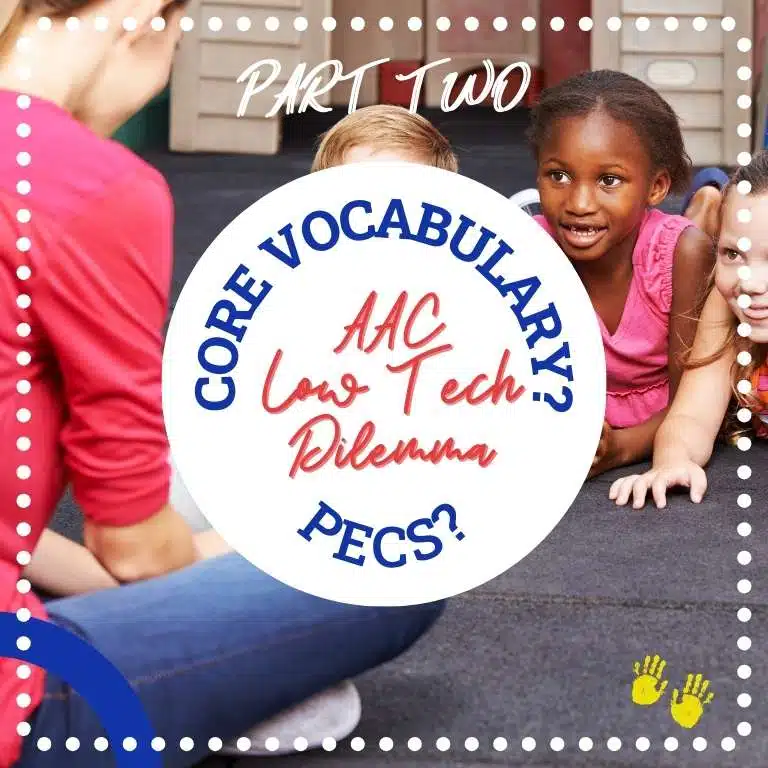
Core Vocabulary or Pecs?
Part 2
Which one should I use for Low Tech AAC?
When considering AAC options for children with language delays, speech language pathologists often ask: “What is a good low tech option? Should I use PECS or a Core Vocabulary approach? In my previous post, we took a look at the Picture Exchange Communication System (PECS). Today, I’ll discuss the pros and cons of Core Vocabulary.
What is Core Vocabulary?
Core Vocabulary uses a picture communication board, usually no bigger than a letter-sized piece of paper, with evenly spaced squares for target words. The board may contain only a few target words or up to 72 words or more, depending on the ability of the user. Instead of handing a picture to a communication partner as one does with PECS, the student points to a picture on the communication board.
A Core Vocabulary communication board focuses primarily on pronouns, verbs, prepositions, and descriptive terms, rather than on nouns. The core vocabulary contained on the communication board consists of the most frequently used words of young children. We use core words in multiple situations, with multiple people and in multiple environments.
 Did you know that adults use around 200 words 80% of the time? Isn’t that incredible?
Did you know that adults use around 200 words 80% of the time? Isn’t that incredible?
“Fringe” words, on the other hand, are situation specific and do not appear on the main part of the communication board. In the picture to the right, the fringe words are along the top.
The noun “scissors,“ for example, is a fringe word. It’s used only in specific situations, such as when you need to cut something. However, the verb “cut“ is a core word. It is used in multiple ways. For example, “Please cut this apple,” “I’m going to cut my hair,” “I need to cut the tree down,” or “I cut my arm.
The verb “cut” can be used repeatedly in multiple ways, whereas the noun “scissors”…not so much. In the preceding example, scissors is applicable in only one of them. And, since space is limited on a communication board, it makes sense to use words that are going to get the most mileage!
At first, it may take students time to learn the location and meaning of an icon. However, with repeated practice and modeling by others, motor memory kicks in, and students quickly find the icon they need.
Core vocabulary is also an evidenced-based approach for language development. For more information on AAC Core Vocabulary check out Core Vocabulary or Project Core.
I started using the core vocabulary approach with my students in 2015 after I learned about it at an AAC conference. I wasn’t sure I’d like it more that PECS, but I wanted to give it a try and see for myself. After just a few months, I was hooked!
For an Introduction to Core Vocabulary, watch this video.
Now let’s take a look at the Pros and Cons of CORE VOCABULARY
PROS
- The use of physical cueing is optional.
- You don’t need extra personnel.
- Materials are relatively simple to prepare.
- The system can be used throughout the day with multiple people, situations and environment.
- The communication board is very portable but multiple copies can also be placed in different areas of a home or classroom.
- Adults can learn on their own…attendance at a workshop is not required.
- Parents can implement at home with minimal training.
- A range of pragmatic skills can be taught, such as requesting, asking and answering questions, commenting, and protesting.
- Facilitates communicative turn taking.
- Easy to incorporate Aided Language Stimulation.
- Adults can use their creativity when implementing the program.
- Encourages verbal communication. Children often start spontaneously verbalizing while pointing to the pictures, especially if their communication partners have done so.
- Students who can’t manipulate individual picture cards can often point to pictures instead.
- It can be used with modifications, such as eye gaze.
- It’s easy to use to expand utterance length.
- A great stepping stone to a more sophisticated device since the student will already know how to point to pictures to communicate.
CONS
- Step-by-step instructions are not available.
- No set curriculum or lesson plans to use as a guide.
- Core words are not universal from class to class or school to school.
- There are a limited number of pictures/words on one board.
- As the number of pictures/words on the board increases, it becomes more difficult to differentiate the icons from each other.
- With a large number of pictures on a board, it takes longer to find the desired picture, especially until muscle memory kicks in and the student automatically remembers where the icon is located.
- It can be intimidating for adults at first, especially when there are a large number of pictures on a board.
- If adults, teachers and/or peers fail to teach and model the use of the board, it’s difficult for the student to learn to use it.
To see Core Vocabulary in action, check out the video.
Which one should you use?
I think both Core Vocabulary and PECS are useful low tech option for students who are nonverbal or who have limited language. I’ve had wonderful success with both of them. However, one approach may be better than another depending on the student and your classroom situation.
Recommendations for when to implement a Core Vocabulary approach.
From my experience, a core vocabulary approach is best when your student easily initiates communication, engages in joint attention, and understands cause and effect. It also helps if your student already imitates gestures and/or the words of others. This ability will transfer nicely as the communication partner models how to use the board by pointing to the icons.
Physical cues may be used at the very beginning of training; however, physical cues are not necessary for student success. Therefore, if your student doesn’t like to be touched, use this system! Core vocabulary is also a good alternative to PECS if your student is not able to manipulate individual picture cards. In addition, core vocabulary is a great portable system; if laminated, a core board lasts a long time, even when taken outside. The boards are easily reproduced and placed in a variety of places in a room. Finally, if parents want to use the approach at home, it’s easier than PECS to provide the materials and teach them how to use the board.

